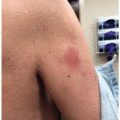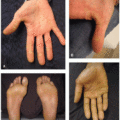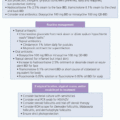Proteasome Inhibitors
Abdulhadi Jfri
Victor Huang
Ian W. Tattersall
Proteasome inhibitors are a group of agents that inhibit the ubiquitin proteasome pathway, which regulates multiple cellular processes, including cell growth and proliferation, DNA repair, transcription, cell signaling, immune response, and apoptosis. The US FDA has approved three proteasome inhibitors, including bortezomib, carfilzomib, and ixazomib, for use in multiple myeloma and mantle cell lymphoma treatment.1 Bortezomib is the most widely used historically; thus, most of our understanding of proteasome inhibitor skin toxicity is based on associations with this drug.
Patients treated with proteasome inhibitors frequently experience gastrointestinal distress, peripheral neuropathy, and thrombocytopenia. Skin is also a common site of toxicity, with 10% to 24% of patient experiencing a heterogeneous array of cutaneous adverse events.2
Proteasome inhibitors have most commonly been associated with a papulonodular eruption that can present as tender, edematous nodules and plaques on the face, trunk, and extremities (Figure 37.1). These lesions may demonstrate a “cockade shade” pattern, with a round edematous plaque with a central vesiculation or petechia (Figure 37.2) or may have morphologic overlap with Sweet’s syndrome or vasculitis, both of which have also been independently described in association with proteasome inhibitor therapy. Biopsy may demonstrate vasculitis. These lesions typically present during the third or fourth cycle of bortezomib and resolve within a few days after the last dose in the cycle, but often recur with continued treatment. Low-dose prednisone and oral antihistamines can be used for symptomatic relief or to prevent recurrence.2
Though this papulonodular eruption can histologically demonstrate vasculitis, a more morphologically classic cutaneous vasculitis is also seen with proteasome inhibitor therapy and may present as above with centrally vesiculating or petechial round nodules or as nontender, purpuric papules and plaques; both presentations favor the trunk. Fortunately, this has never been reported to be associated with systemic vasculitis.2 Management may include a short course of systemic steroids tapered over 1 to 2 weeks, or low-dose systemic steroids in off treatment weeks. Of note, the development of cutaneous vasculitis during bortezomib treatment has been associated with better clinical response in patients with non-Hodgkin lymphoma.3
Stay updated, free articles. Join our Telegram channel

Full access? Get Clinical Tree







